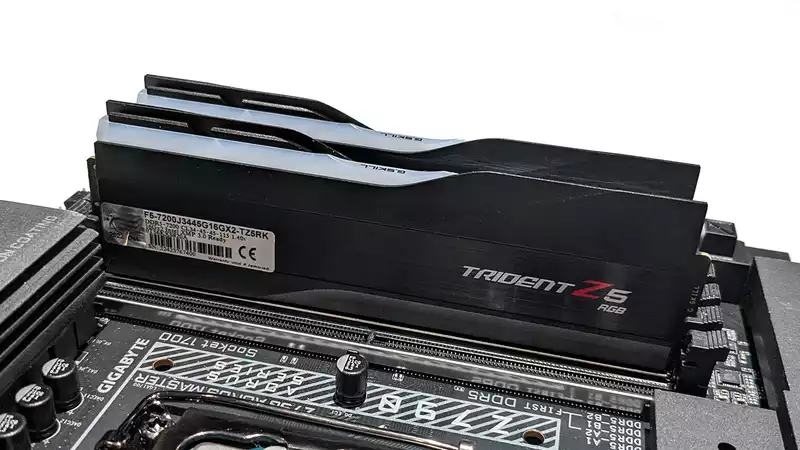DDR5 has come a long way in the year or so since its introduction. It is now widely available, the price has come down, and the initial BIOS glitches have been overcome. And then there is the speed. When the 12th generation (open in new tab) Alder Lake CPUs were released, DDR5-6400 was the highest speed, but forget that: DDR5-8000 kits (open in new tab) are now available. Not a bad improvement in just over a year.
The kit we will be reviewing is G.Skill's Trident Z5 RGB DDR5-7200 kit. This kit is still very fast, but not fast enough to matter on anything but the highest spec overclocked boards. Still, it is worth checking the QVL list to make sure the board can handle the XMP settings; for AMD, you should consider an EXPO kit in the DDR5-6000 range for maximum compatibility.
After all, this kit can be considered second generation DDR5. This kit contains the Hynix A-die chip, which we believe is used in all of the highest spec modules available today. This chip operates at a higher frequency than the Hynix M-die found in most first generation DDR5-6000+ kits.
Memory at this speed is expensive, and the price of $299/£319/519 Australian dollars is certainly pricey, but not really that bad. As of this writing, a 6000 MHz kit starts at about $150 and a 6400 MHz kit at about $190. In fact, compared to the premium DDR5 prices of a year ago (open in new tab), when prices of $500/£500/$1,000 AUD or more were the norm, they are a veritable bargain.
The G.Skill Trident Z5 DDR5-7200 kit has timings of 34-45-45-115. It is nice to see that CAS latency remains relatively low even at the increased speeds, but secondary timings are much higher than the slower kits. The best DDR4 kits are still perfectly viable, but the initial complaints of high DDR5 latency compared to DDR4 are quickly becoming moot. [This kit comes in 2x16GB capacities, supports XMP 3.0, and has an operating voltage of 1.40V. Our review sample is in black, but it is also available in silver. Frankly, the black version will blend in better with a wider range of builds.
G.Skill has not changed the appearance of the Trident Z5 kit. It features a more opaque appearance than most kits, giving it a classy, understated look. Personally, I prefer that to individual LEDs, which are so bright they might damage your retinas.
RGB lighting can be controlled via a common motherboard vendor app or G.Skill's own simply-named Lighting Control app. This app is simple and lightweight at 5.7 MB. There is no unnecessary bloatware; G.Skill has done well.
So what about its performance? This is the eternal question of PC gamers, and it is especially interesting given the dramatic increase in gaming performance that cards like the Nvidia RTX 4090 (opens in new tab) can provide.
First, looking at the system benchmarks, we see that the traditionally memory-sensitive apps are doing well, especially in the file compression and video encoding tests. However, the AIDA64 results are purely composite and are more of a comparison test than actual real-world performance.
This is where gaming gets interesting, and an area that I was personally very interested in given the performance leap that the RTX 4090 offers. Frankly, while there are some clear advantages, I was hoping that the faster memory would bring more benefit than it actually does.
Traditionally CPU-limited games like Far Cry 6 benefited, but the bigger surprise was the effect on Cyberpunk 2077, which is noted for being very GPU-intensive. Average FPS scaled well with faster memory speeds; Metro Exodus is another example of a GPU-intensive game being scaled by memory, but to a lesser degree. [But not all games benefit. Total War: Warhammer III" and "Ghost Recon: Breakpoint" both show no real gains when compared to DDR5-4800.
In summary, the status quo has not really changed. Buying top-of-the-line DDR5 only makes sense if you have a comparable high-spec system; think Core i9 13900K (open in new tab) and RTX 4080 (open in new tab) or higher. Otherwise, you may want to put the extra money toward a faster CPU or GPU that offers more tangible performance gains.
Overclocking proved to be difficult, but that is not the fault of the memory itself; DDR5-7600 was bootable at 1.45V on the Z790 Aorus Master, but the increased memory voltage did not help, only the IMC voltage. If you have a motherboard that specializes in overclocking and are not afraid to push the envelope and play with the timings, you can get over 8000 MHz with a good memory controller if you are lucky. Without a 13th generation processor and a Z790 motherboard, this kind of kit is a waste of time.
Relying on XMP above 7000 MHz is not recommended if your motherboard struggles or tries to apply strange voltages. Adjusting it yourself is a sure bet.
G.Skill rarely disappoints when it comes to fast memory. If you are looking for fast memory, G.Skill is usually at the top of the list; the Trident Z5 RGB DDR5-7200 kit is highly desirable, but as is usual with fast memory, it is not for everyone.
This is a kit for those with high-end systems. But at $299/£319/$519 AUD, it's actually quite a bargain when compared to the cost of other components in a high-end gaming system. Then there's no harm in buying it. But if your system is a bit more secular and you're looking for something with an easier XMP setup, something in the DDR5-6000 range is much more appropriate, both in terms of price and performance.
I do, however, love fast memory kits. These kits are actually available for purchase and can improve performance in more than a few gaming situations. If you buy this kit, you can keep using it for several years.
If you have a comparable high-end system that matches this class of kit, I would recommend it.
.

Comments